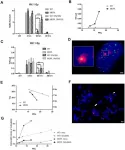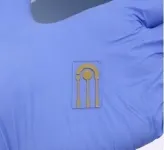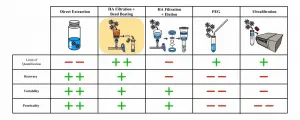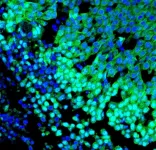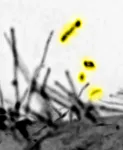(Press-News.org) Aging-US published "Functional analysis of POLD1 p.ser605del variant: the aging phenotype of MDPL syndrome is associated with an impaired DNA repair capacity" which reported that Mandibular hypoplasia, Deafness and Progeroid features with concomitant Lipodystrophy define a rare systemic disorder, named MDPL Syndrome, due to almost always a de novo variant in POLD1 gene, encoding the DNA polymerase δ.
A decline of cell growth, cellular senescence and a blockage of proliferation in G0/G1 phase complete the aged cellular picture.
Moreover, the rate of telomere shortening was greater in pathological cells, suggesting the telomere dysfunction as an emerging key feature in MDPL.
These http://www.Aging-US.com results suggest an alteration in DNA replication/repair function of POLD1 as a primary pathogenetic cause of MDPL.
The understanding of the mechanisms linking these cellular characteristics to the accelerated aging and to the wide spectrum of affected tissues and clinical symptoms in the MDPL patients may provide opportunities to develop therapeutic treatments for progeroid syndromes.
Dr. Maria Rosaria D'Apice The Tor Vergata Hospital and Dr. Antonella Sgura from "Roma Tre" University said, "Mandibular hypoplasia, Deafness and Progeroid features with concomitant Lipodystrophy, represent a rare systemic disorder, named MDPL syndrome (MDPL; OMIM #615381)"
MDPL was described for the first time in 2010, reporting seven subjects showing a clinical phenotype overlapping with mandibuloacral dysplasia syndromes such as mandibular hypoplasia, prominent eyes, stiff joints, beaked nose, and lipodystrophy, but also specific additional clinical hallmarks, including sensorineural hearing loss, hypogonadism and absent clavicular hypoplasia/acroosteolyses.
MAD and MDPL belong to the group of diseases characterized by premature aging, which can be caused by inheritable nuclear envelope and/or DNA repair defects.
Song and colleagues also demonstrated that POLD1 downregulation is able to block the cell cycle at G1 and G2/M phases and results in reduced DNA synthesis, demonstrating the potential role of POLD1 in the regulation of cell cycle progression.
Polδ serves to repair DNA lesions arising as a result of exposure to mutagens, acting in multiple forms of DNA repair, including nucleotide excision repair, double strand break repair, base excision repair, and mismatch repair.
In particular, these researchers shed light on the capacity of MDPL cells to respond and repair DNA induced-damage, especially at telomeric level.
The understanding of the pathogenic mechanism lying at the basis of the MDPL syndrome allows us to explore the link existing among DNA repair and age-related diseases.
The D'Apice/Sgura Research Team concluded in their Aging-US Research Output, "In order to respond to some of these intriguing questions, we are now generating human induced pluripotent stem cells from patient's fibroblasts for applying genome-editing technologies, like the CRISPR-Cas9 nucleases, as tool for drug screening applications targeting DNA repair and development of therapeutic treatment."
INFORMATION:
Sign up for free Altmetric alerts about this article
DOI - https://doi.org/10.18632/aging.202680
Full Text - https://www.aging-us.com/article/202680/text
Correspondence to: Maria Rosaria D'Apice email: d.apice@med.uniroma2.it and Antonella Sgura email: antonella.sgura@uniroma3.it
Keywords: MDPL syndrome, POLD1 gene, age-related disease, DNA repair, telomere damage
About Aging-US
Launched in 2009, Aging-US publishes papers of general interest and biological significance in all fields of aging research as well as topics beyond traditional gerontology, including, but not limited to, cellular and molecular biology, human age-related diseases, pathology in model organisms, cancer, signal transduction pathways (e.g., p53, sirtuins, and PI-3K/AKT/mTOR among others), and approaches to modulating these signaling pathways.
To learn more about Aging-US, please visit http://www.Aging-US.com or connect with @AgingJrnl
Aging-US is published by Impact Journals, LLC please visit http://www.ImpactJournals.com or connect with @ImpactJrnls
Media Contact
18009220957x105
MEDIA@IMPACTJOURNALS.COM
Researchers at the DZNE (Germany), at Massachusetts General Hospital (USA) and at the genomic medicine company Sangamo Therapeutics, Inc. tested a novel gene regulation approach to treat brain diseases such as Alzheimer's in laboratory studies. It leverages zinc finger proteins, which specifically bind to the DNA that codes for the protein Tau without altering it, thereby reducing Tau production in the brain and preventing nerve damage. The preclinical results, published in the journal Science Advances, could lay the foundation for new therapies.
The Tau ...
The efficacy of biosensors used in clinical tests depends critically on the surface of the device on which the biorecognition molecules are immobilized. This surface can be adjusted and sometimes controlled using self-assembled molecular monolayers as matrices. The monolayers are films made up of organic molecules that under the right conditions assemble spontaneously on metal surfaces via chemical bonds between the sulfur atoms and the metal.
A study conducted at the University of São Paulo's São Carlos Physics Institute (IFSC-USP) in Brazil compared the performances of two types of self-assembled ...
Myelodysplastic syndrome (MDS) is a disease of the stem cells in the bone marrow, which disturbs the maturing and differentiation of blood cells. Annually, some 200 Finns are diagnosed with MDS, which can develop into acute leukaemia. Globally, the incidence of MDS is 4 cases per 100,000 person years.
To diagnose MDS, a bone marrow sample is needed to also investigate genetic changes in bone marrow cells. The syndrome is classified into groups to determine the nature of the disorder in more detail.
In the study conducted at the University of Helsinki, microscopic images of MDS patients' bone marrow samples were examined utilising an image analysis technique based ...
Greenwood, SC (March 22, 2021) - A research team at the Greenwood Genetic Center (GGC) has identified the mechanism that causes movement disorders in patients with mutations in the NUS1 gene. Using both cellular and model organism studies, cholesterol accumulation was found to contribute to the symptoms of seizures, ataxia, and movement abnormalities. This breakthrough study on NUS1, a gene that has also been potentially linked to Parkinson's Disease, is reported in the current issue of Genetics in Medicine, the Journal of the American College of Medical Genetics and Genomics.
Chloe Murphy, 15, of Bluffton, SC began experiencing tremors at age three. Through the years she has also experienced seizures, atypical eye movements, learning delays, ...
Reston, VA--A new treatment for late-stage neuroendocrine tumors (NETs) has been found to be more effective and have fewer side effects than the current standard of care, according to research published in the March issue of The Journal of Nuclear Medicine. The novel peptide receptor radionuclide therapy holds promise to reduce mortality among NET patients and decrease the financial burden of their continual treatment.
NETs are a diverse group of tumors that originate from the neuroendocrine system, which is responsible for regulating hormones throughout the body. The number of people who are diagnosed with NETs is growing; the incidence of NETs increased 6.4-fold from 1973 to 2012. However, because they are rare, varied, ...
HOUSTON - (March 22, 2021) - There are many ways to test municipal wastewater for signs of the virus that causes COVID-19, but scientists in Houston have determined theirs is the best yet.
A study led by environmental engineer Lauren Stadler of Rice University's Brown School of Engineering with the aid of the City of Houston Health Department and Baylor College of Medicine compared five processes used by labs around the country to concentrate samples and find the virus in wastewater from six Houston plants.
The process employed at Rice and now Baylor, called "electronegative filtration with bead beating," proved the most sensitive to signs of the virus as well as the most cost-effective.
The study appears in the Elsevier journal Water Research.
There ...
Breast cancer is the most common type of tumour found in women. 69,000 new cases are diagnosed each year in Germany alone. Around 80 percent of tumours originate in the luminal cells, the milk-producing cells of the mammary gland. 10 percent of the cells resemble those of the underlying (basal) cell layer. These are muscle-like epithelial cells that contract when the mammary gland produces milk in order to push it out.
"While luminal breast tumours are usually sensitive to hormones, 80 percent of basal-like tumours are triple-negative. They have no receptors ...
Scientists from the University of Leeds's Nutritional Epidemiology Group used data from 500,000 people, discovering that consuming a 25g serving of processed meat a day, the equivalent to one rasher of bacon, is associated with a 44% increased risk of developing the disease.
But their findings also show eating some unprocessed red meat, such as beef, pork or veal, could be protective, as people who consumed 50g a day were 19% less likely to develop dementia.
The researchers were exploring a potential link between consumption of meat and the development of dementia, a health condition that affects 5%-8% of over 60s worldwide.
Their results, titled Meat consumption and risk of incident dementia: cohort study of 493888 UK Biobank participants, ...
Ikoma, Japan - What if you found out that you could heal using only a finger? It sounds like science fiction, reminiscent of the 1982 movie E.T. Well, it turns out that your body's own cells can do something similarly unexpected. Researchers at Nara Institute of Science and Technology (NAIST) report in a new study seen in Developmental Cell a means by which cells may use "fingers" to communicate instructions for wound closure.
NAIST project leader Shiro Suetsugu has devoted his career to studying how cells shape themselves, initiate and accept communication among one other. An under-appreciated means of doing so is through filopodia, small finger-like ...
WHAT:
Children in high-poverty neighborhoods who participated in a comprehensive preschool program that provided parents with health and educational services and job training had a lower body mass index (BMI) in their late 30s than a similar group who participated in the usual early childhood programs, according to a study funded by the National Institutes of Health. The study authors concluded that comprehensive, school-based early childhood programs could lead to improvements in body mass index later in life. The study was conducted by Arthur J. Reynolds, Ph.D., of the University of Minnesota, and colleagues. It appears in JAMA Pediatrics. ...
